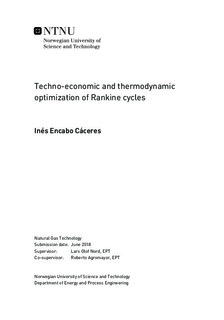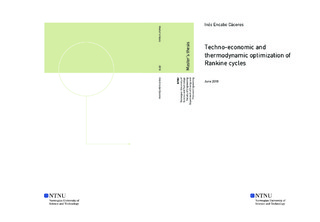| dc.description.abstract | Rankine Cycles are an effective and efficient way of producing power from low-medium temperature heat sources when combined with low-medium critical temperature working fluids. The technology provides high flexibility in design, not only because of the great number of working fluids that can be selected for the system, but also because of the wide range of possible configurations and layouts the cycle allows to work with. When designing a Rankine cycle, the thermodynamic assessment alone is not an exhaustive indicator of the optimal configuration, mainly because every working fluid has very different properties, which have a great impact not only on the performance of the cycle, but also on its size and, therefore, on its cost.
This work is focused on the thermodynamic and techno-economic optimization of simple subcritical Rankine cycles for a low-medium temperature geothermal heat source application. Two case studies were analyzed. The first one consists on optimizing the Specific Investment Cost of the plant for 4 different heat exchangers configurations and a given scenario (a heat source of 10 kg/s water flow rate at 120 ºC and a cold sink inlet temperature of 10 ºC), and determining which configuration gives the best results and for which set of working fluids. The second case study lies in evaluating and comparing the optimum thermodynamic and techno economic performance of the plant for different varying heat source and heat sink conditions, for the best set of working fluids that was found in the previous case study (plus benzene and pentane) and the most suitable heat exchangers configuration. For both case studies, the geometry design of the cycle heat exchangers was determined by an optimization code developed in MATLAB, computing all the thermodynamic states of the cycle, pressure drops and heat transfer coefficients in the heat exchangers, and cost components.
Results show that resorting to plate heat exchangers minimizes the Specific Investment Cost of Rankine cycles, especially when using working fluids with a Tmax/Tcrit close to 1. The working fluid selection, and the heat source and cold sink inlet conditions, have a great impact on the performance and cost of the system, which are always reaching the best results when ammonia is used as the system working fluid. Moreover, the techno economic and thermodynamic optimizations give completely dissimilar results, not only when analyzing the size of the system components, but also when looking at the heat exchangers geometry design, the operating pressures, or the degree of super-heating at the inlet of the expander, among others. In general, better cycle performances can only be reached in exchange for higher investment costs. | |

